On the face of it the Q400 has a lot of things going for it. It was always going to be overshadowed somewhat by the more powerful RK2020, but judged on its own merit it’s quite an intriguing little machine. Unfortunately it hasn’t panned out well for the Q400 yet. I haven’t written it off yet though, there may be hope. Read on for the Supbor Q400 review.
When the Q400 was first announced the RK2020 wasn’t born and the OGA was sold out everywhere. Despite the RK3128 CPU in this handheld being less powerful than the RK3326 in the RK2020 and OGA, it still stands head and shoulders above the RG350 and PocketGO V2 in terms of raw power. Add to that some nice features such as an 800×480 display, working HDMI output and the ability to play 4 player games and you’d think you’d have a winner on your hands. Let’s find out.
BUILD QUALITY
After reading the early translated reviews on the Chinese forums, my expectations were fairly low here. As it happens though, there is very little to complain about. The machine is really well built in some areas, and I think the shell design is excellent.

Instead of being made with two equally sized pieces of plastic that meet with a ridge running around the middle of the device, the main body of the Q400 is all one solid piece. A backplate closes up the shell neatly with 4 cross head screws.
For a device as wide as this, you might expect it to creak but it feels pretty sturdy. The Q400 is a whopping 174mm wide. To put it in perspective, the RG350 is just 144mm, so the Q400 has an extra 3 centimetres on it.

CONTROLS
The ABXY buttons are nicely clicky and the analog sticks are beautiful. Each stick could also have an L3/R3 function as they click when pressed. The d-pad is one of the more strange aspects of the Q400. It’s actually OK to use, but its legs are about 3-4mm too long in each direction. It could also do with having a bit more of a pivot to it, there is one but it’s very shallow. The d-pad is slightly convex in the middle, tapering up towards each extremity. There are far worse, but it does take a little getting used to.

The shoulder buttons are the Q400s weakest link when it comes to the controls. L1 and R1 wrap around the edge of the device and the L2/R2 buttons sit a couple of millimetres further in. Unfortunately they are really clicky, requiring a pretty reasonable amount of force before they depress. L1 and R2 are most easily pressed by pushing them from the sides, where they wrap around the shell. They’re usable but you have to be conscious of how to hit them, and unfortunately they’re pretty bad.

Underneath ABXY are start, select, volume- and volume+ buttons. They’re small and clicky and they don’t get in the way of ABXY despite their placement.

On top of the unit there’s a microSD slot, a Micro USB charging port, HDMI and headphone outputs and an on and off switch. On the bottom of the unit are the 4 USB-A host ports for plugging in your controllers.
LCD
There was a lot of hullabaloo around the LCD in the early reviews. Many of the Chinese reviews complained of terrible ghosting and screen tearing, but I think the manufacturers switched out the panel before releasing to the rest of the world.
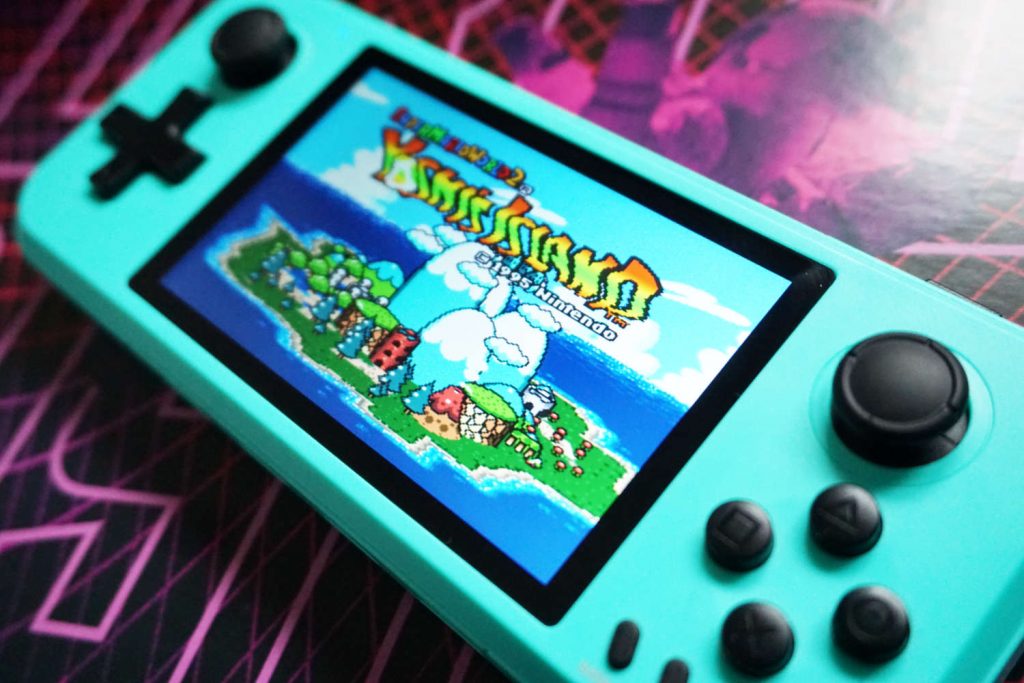
The IPS display is actually really nice. It’s not often you get 800×480 displays in these things and the pixel density is great. Viewing angles are excellent in every direction too.
It’s a strange choice of aspect ratio for a machine like this. Aside from a tiny handful of widescreen enabled PS1 and N64 games, you’re going to either have a stretched image or black bars either side. More on that later.
You might be wondering how it can be that I’m praising the display whereas Taki Udon said it was terrible. The review Taki did wasn’t of the stock OS, he’d replaced the stock system with a RetroArch build that he got from somewhere. The problem is the image he used contained the driver for the older LCD, the one with ghosting and tearing. His unit has an IPS display like mine, which means he flashed a largely incompatible image to the unit. With the right driver, the display is pretty damn good.
SOFTWARE
If you’ve gotten this far and you’re about to go and buy a Q400, hold up! There was a delay releasing the Q400 to the West because the factory were attempting to get a RetroArch build working on the device first. Unfortunately it was never finished, and instead the device ships with something akin to a Pandora’s Box interface. Whilst the GUI and UX are more or less tolerable, there are some severe limitations which make the shipped system really irritating.
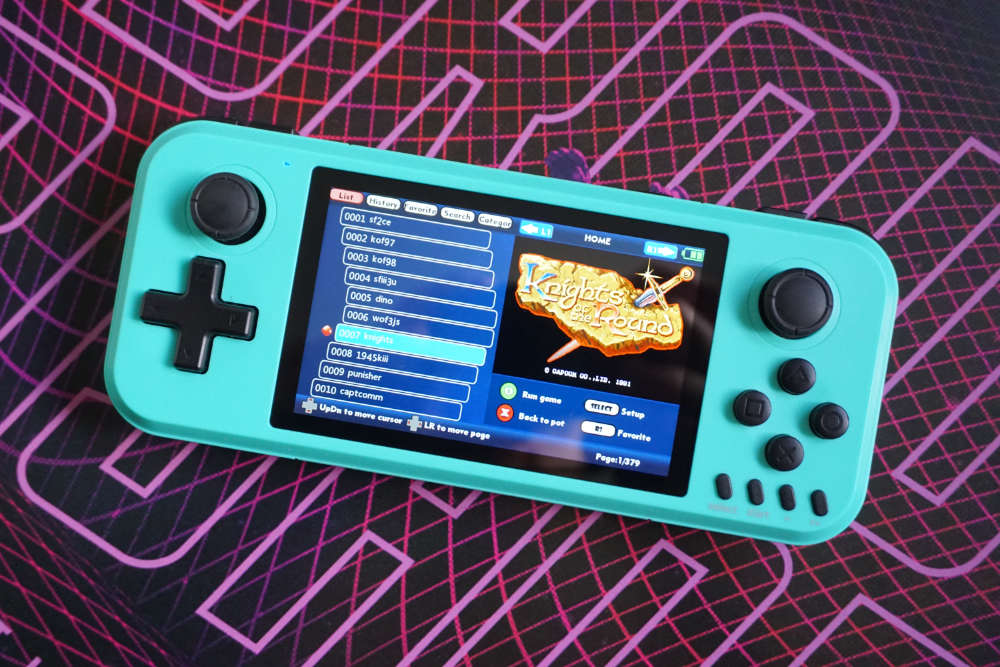
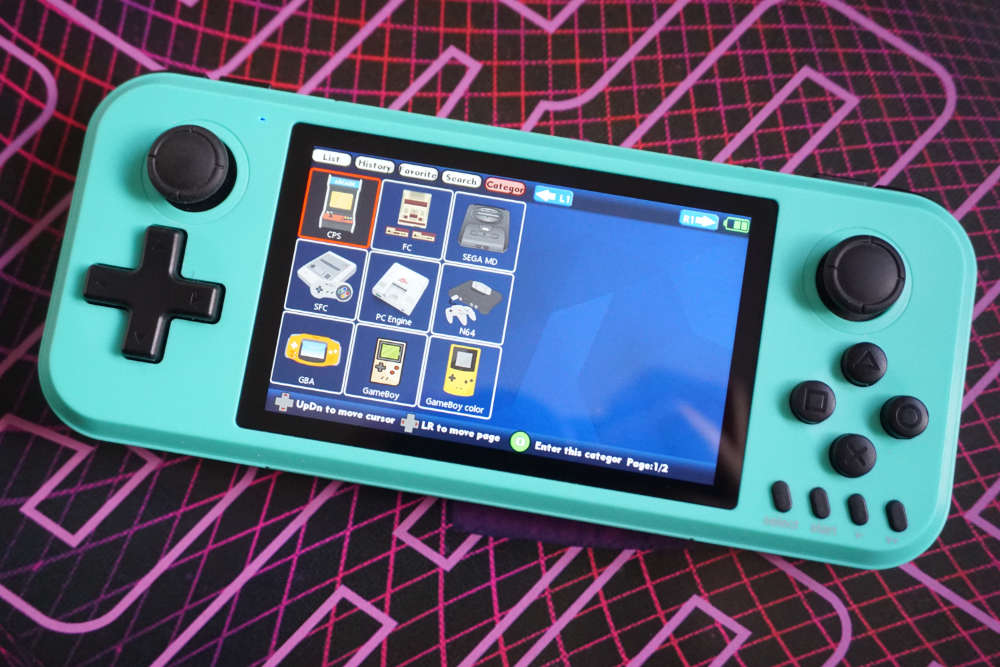
The biggest turn off for most people is going to be that you cannot (to the best of my knowledge) alter the aspect ratio of any game. They all play in full widescreen and for the most part look really horrible for it. You can bring up a menu in game by hitting Start + Select, but your options here are limited.

In a last ditch attempt to try and find some hidden menus somewhere, I plugged in a keyboard and bashed random button combos for a bit. I found that ctrl+esc brought a menu in the lower left corner with the title “MiniGUI”. Unfortunately after exploring all the sub-menus I didn’t find any extra options. I also tried this whilst running some emulators, but couldn’t find any menus there at all.
EMULATION
N64 emulation in its current state is a no go. The emulator is Mupen64Plus, exposed by a config file in the ROMs directory. But the mixture of a slightly under powered chip and poor optimisation could be the reason it doesn’t perform well. I played a couple of races in Mario Kart 64 which is a game that runs well on most devices that support N64, but it doesn’t run well here. It’s probably about 60-70% speed with severely glitchy audio. There are no frameskip options to change in the menu.
PS1 is far better, but the stock system won’t launch bin/cue images as far as I can tell. Most games for the other systems run quite well, as you’d expect. Yoshi’s Island on the SNES runs pretty well, Star Fox runs acceptably but at a lower framerate. With the right software tweaks, I do think it’d be possible to run iron out SNES and introduce some N64 games well.

I only have one controller and it’s an 8BitDo N30 Pro 2. Unfortunately whilst it’s recognised by the unit, I cannot get the controls correctly mapped. I’ve tried xinput and dinput modes but the d-pad and analog sticks are not recognised by the Q400 system.
RETROARCH
I was able to get a build of RetroArch with the correct LCD driver for the Q400. It comes precompiled and the factory are apparently unwilling to release their source code. My Q400 hasn’t yet crashed in game like it does in Taki’s video, but it is unstable. Scrolling through the menus I have experienced some strange behaviour and a couple of crashes to a blue screen too. I have very little experience with RetroArch so there could be some “user error” but I can say with some confidence that RetroArch is still unstable on this device. Whether that can be fixed with config files, or whether it needs fixing in source code I don’t know.

It is possible to change the aspect ratio of some systems under RetroArch, but for some reason to get a correct 4:3 ratio you actually have to choose 3:4. I suspect this is something to do with the panel identifying itself as portrait rather than landscape but I’m not totally sure. N64 performance is still not great under RA, but again – it could be that fiddling with some settings improves this. I’m reluctant to invest too much time in it though, since the port still seems to be unfinished and unstable. If anyone has any suggestions on how to improve N64 under RetroArch though, do let me know. I am happy to test them out. HDMI output does work on RetroArch, and on a 1080p display it looks very nice.
FLASHING RETROARCH
Be aware, this will not work on a non-IPS version of the Q400. It will brick your device. It is also not guaranteed to work on your device at all, so please bear that in mind.
If you’re getting a Q400 and want to have a mess around with RetroArch you can download everything you need from here. I’ve included the stock image too, so you can revert it if you like. I would advise using a different SD card for your ROMs on each OS since the stock system is picky about the layout of the card. The below screenshot shows you what buttons to hit to flash the image. The button will go green once completed. Instructions are in the download. The flasher is required because the OS is not stored on a microSD card like most other systems.
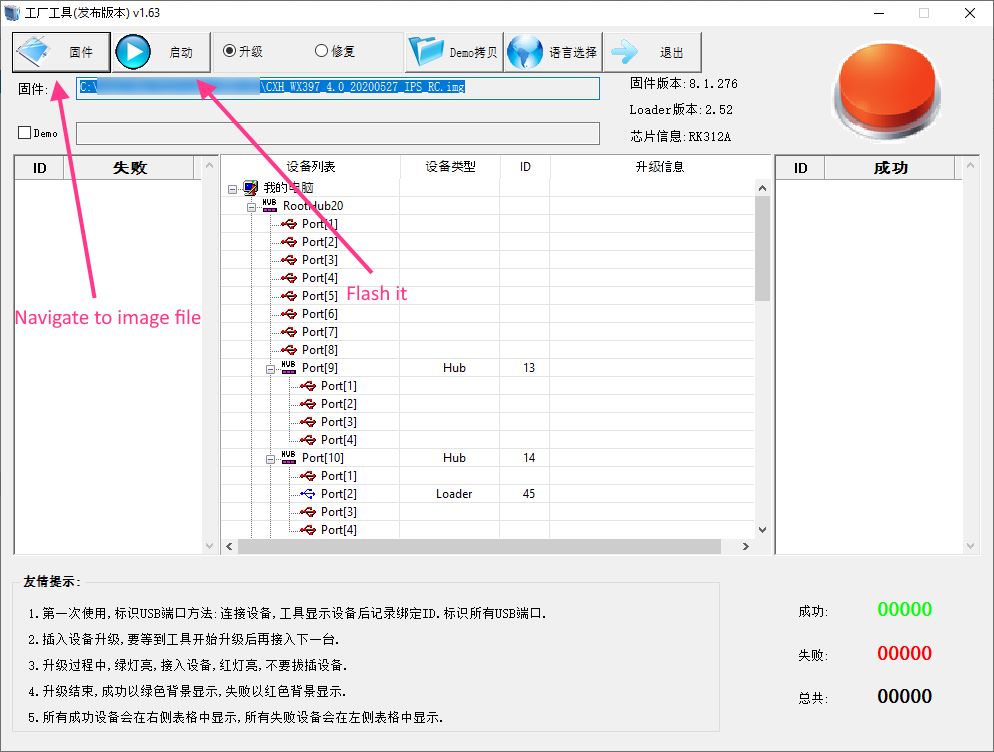
SHOULD YOU BUY THE Q400?
If I’m being kind, I would say that the stock system is reasonable for the lower end systems – if you’re not bothered about the incorrect aspect ratio. For me it’s a deal breaker, and the lack of customisation or ability for outside support for this OS is sad. This is a case of another reasonably solid piece of hardware being tainted by the software. If the factory released the source code for this device, I’m sure someone would fix it. It may get fixed anyway, we’ll see.
I will say one thing in favour of the stock system, it is child proof. If I was going to buy a handheld for a youngster I would be reluctant to go for system running OpenDingux or EmuELEC etc, because it’s very easy to break things if you start pressing random buttons. The stock system on the Q400 is very easy to use and it is impossible to mess anything up. If it was configured correctly I could live with this lack of customisation, but as it stands it needs some tweaking to meet the majority of people’s standards.

I waited a bit before reviewing this machine in the hope that the factory released a new software update. I wanted the SupBor Q400 review to be a bit more positive than this. Right now it’s another one to keep our eyes on, a miracle may happen. We’ll have to wait and see.
The Q400 is for sale at AliExpress for about $80. It’s worth noting that there is another seller with this for $54, which seems very low. I don’t know if the $54 version is the one with the IPS screen or not.

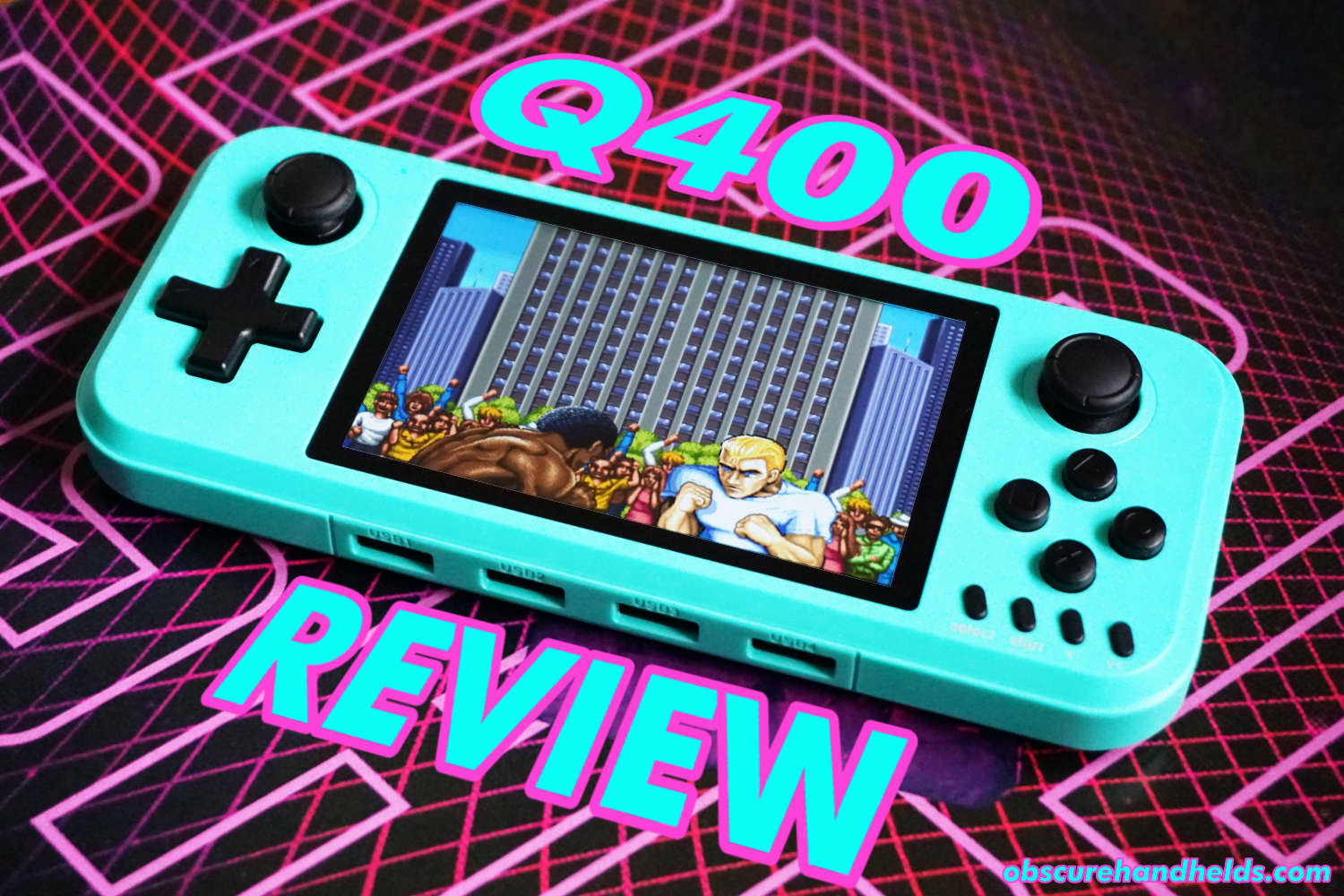
Does anyone know where I can find the stock firmware from the non-ips version, compatible with FactoryTool or RKDeveTool?
i think the company and handheld are doa …
Any rumors about a firmware update for this device lately?
How many RAM in this device and whats the ROM partition size for the OS ? Is it possible to install retropie?
I flashed the Retroarch firmware and in the application, it shows success. However, the Q400 refuses to boot. There is audio coming out of the speakers as I press the directional buttons but the screen is completely blank. Would you perhaps have another variant of the rom? Or perhaps, someone could share some light on why this is happening?
What happens if you re-flash the stock image?
The same happens. When booting the screen flashes for a sec and a series of horizontal white lines flashes for a sec before turning back to black screen. Apparently, there are sounds coming out when you press on the buttons. You could even access the games, but the screen remains black.
Just for the benefit of anyone reading this thread, we discussed the issue in discord and I am trying to get hold of the non-IPS firmware image for Shane. I’ll post it here if it materialises.
Hey any update for non-IPS as mine is done as well.
Unfortunately this device was abandoned by the manufacturers, vendors and community. Something might happen one day, but if yours is bricked then I think you’re out of luck in afraid.
The price on their website is reduced now. Wish I could have waited. I just got a dumb console which is of no use to me.
I wonder if theyll update the software on this device someday.
Thank you for your attention to detail – here and in general on this site. Unfortunately @taki Taki Udon often comes out with nonsense information on his channel but presented as authoritative fact. His understanding of the tech he’s promoting – particularly regarding things like screen resolutions is not good. He needs to learn more if he’s recommending or discouraging particular devices. Often I find he’s just bias to a particular tech. I don’t currently trust his knowledge on his chosen subject. Both his and RetroDojo (who currently are even worse, shocking even, in their knowledge set) present themselves as experts in the handheld space – when they are clearly not – and it does good products damage and lets bad tech get credit. They really should go for more of an enthusiast angle and stop presenting guessed information as definitive.
Sorry to be a bit heavy with this view and I hope they improve their respective channels, but @taki, it is a problem.
Oh boy, what a shame this is! The hardware is great and even the design is nice, but the software… the interface is buggy and unpleasant and options are extremely limited. As far as emulation is concerned, it’s not too bad, though I get sound issues (cracking) on some systems (GameBoy advance, Sega Genesis).
The overall feeling is amateurism at best: this could have been a great affordable emu handheld if Supbor had put some more effort into dev & QA…
I haven’t tried RA on it yet, but I’m not willing to spend time on it until they solve the stability issues (if they ever do).
Dear Supbor, shame on you!
The stock firmware has ghosting. I could even teach you how to recreate it.
Yeah go on. It wasn’t noticeable to me at all in the games I tested.
I would like someone (admin, cof cof) to modify the motherboard and replace the RK3128 with the RK3326 of the OGA, in theory the hardware should be compatible, if I were an expert in electronics and had both consoles (oga and q400) in my hands I would definitely try it, then the q400 will be the ultimate machine.
And you expect it to run OGA software? with a different screen? and (most likely) different control connections?
have to wonder how DUMB the designers can be…. 16:9 on retro consoles? No proper Retroarch? FFS put Android or Open Source Linux on it and get engaged with community devs and you sell thousands of the things
Yeah, it’s crazy isn’t it.
This ratio isn’t dumb. It would be great for 3x integer scaling on GBA. It’ll do 2x scaling on most other old consoles perfect, aside from the black bars. With better hardware, it would be good for N64 and Dreamcast. It blows my mind that people think this is a bad screen res but the OGA’s isn’t. The problem here is the bad software.
Hey there, I bought the Q400 after your first article about it and I can say: You are absolutely correct. Very good hardware, very poor firmware. But let’s hope they will fix it some time in the future.
I can’t find the link to Retroarch and the flashing tool. Am I missing something? I would give it a try.
Yeah it’s a shame, I really hope it gets some attention. I forgot to link RA, but I’ve updated the article now. It’s a link to Google drive, go wild! Cheers 😉
Most probably they never will, JZ based stuff like RG350 all benefit from the open source community, that’s why they’re stuck with crappy JZ processors, also they choose to do so since they’re targeting retro enthusiasts and they knew software matter, on the other hand supbor targets the kid market, that’s why their software sucks, and they’ll never contribute to the open source community, I’d be glad to be proven wrong but that’s the sad truth now.